
































"Being blind must be difficult living in such a visual world!" Our team threw this question to ourselves and began our final-year project for our undergraduate studies. We thought it would be a good opportunity to learn from a user group that we had never encountered before.


We had our very first conversation with the visually-impaired at the blind massage station in a hospital. Since then, we have met and interviewed people of different ages, profession, personalities, and causes for the visual impairment.


" You said grocery shopping must be so difficult for the blind, but actually it's so easy for me - I just yell out loud for help every time I arrive at the supermarket."
As we dug deeper, we found that even when they share the same condition, loss of vision, some of them live a more active and adventurous life than most of us because they have opportunities to access various resources. "You said grocery shopping must be so difficult for the blind, but actually it's so easy for me - I just yell out loud for help every time I arrive at the supermarket." - Chu Hsin-yi, a counselling psychologist in Taiwan who became visually-disabled due to the brain tumor when she was 17.
Others, however, felt more comfortable to stay in their comfort zone where everyone else is visually-impaired. Going outside and exploring might not be a good option for them since the city was built by the visually-abled. So, how might we make "the outside world" more accessible to them ?
Some insights that were drawn from the interviews include:

How might we increase the body movement and social interaction for the visually-impaired?
According to the insights we have gained, our team decided to design a physical dancing game that let both visually-impaired and visually-abled play together with ease. The players must cooperate to create dance routines, which not only compensates their insufficient amount of exercise but also fortify the connection among them.
We then tried to brainstorm the game mechanics to match the goal. Luckily, one of us is a talented musician who made the music clip we needed for game testing right after we had new ideas!






" the players could easily sense and affect each other's movements during the dance."
By building, testing, and iterating, we came up this duet dancing game called LET'S DANCE. It contains two pairs of gloves which give out sounds and vibrations to instruct the players to the right moves.
Since the game only continues when at least one of their hands are holding, the players could easily sense and affect each other's movements during the dance. However, in order to success the game and make a wonderful dance ( the game only has two challenges so far - Waltz and Tango ), two players must listen to the music carefully and cooperate well.





This is how we wished it would look like if the players always make the right move at the right time:



"..it was the first time they felt like they were dancing."
We invited some visually-disabled users to play our game by reciting the instruction ourselves and playing the dance music with our phones. To our surprise, some of them had never danced before, and it was the first time they felt like they were dancing.
In spite of the lack of dancing experience, while we kept modifying our language of the dance moves tutorial, they could make the required moves by the vocal instruction we designed.
After this breakthrough, we went further by tying smart phones to each of their hands and making them vibrate when they needed to make the moves. And they made it!
Since our game mechanics was approved, it's time to make it real!









Finally, we had our last prototype which not only had space to contain the hardware, but also comfortable to wear. The gloves remove the coverage on fingers to let users feel each other's hands. Meanwhile, different embroidery patterns on each pair of gloves implied the identities.

" It was just the beginning."
There's actually a turning point before we came up LET'S DANCE. During one of the interviews with the owner of a blind massage center, he mentioned that there used to be a local dancing lesson for the visually-impaired but somehow it's stopped. He even asked if we knew someone who could come and teach them to dance, no matter which types. And it gave us the idea of turning dancing more approachable for them by designing a dancing game.

Although our goal sounds meaningful, without actually introducing it into the market, it cannot make an impact.
And since we were studying industrial design with a final exhibition approaching, the outcomes were expected to be tangible and can be displayed in the exhibit.
After feeling relieved that the final exhibition was over, I traced back to our initial goal and started to wonder: Wouldn't it be more influential if we could just find someone to start a dance lesson for them locally? Is it the solution they need?
I know that we could only make a significant impact to people after making extensive iterations and launching it into the public, but as a project for my final-year of studies, I'm very pleased with the whole experience and what we have accomplished.
It was just the beginning.

" As a team that everyone all majored in industrial design, we managed to develop our respective strength."
As a team that everyone all majored in industrial design, we managed to develop our respective strength.
Iris is a talented singer, pianist and composer who has an artistic soul. She was the one who put music elements in our design, and kept inspiring us with her sentimental stories and relaxing afternoon tea.
Yi Chun was like a leader in our team who made sure that we were always facing toward the right direction. He is good at structuring our ambitious concepts into some sentences or diagrams that were easy to understand. He helped us think logically.
To fit in between the sense and sensibility, I found myself playing the role in coordinating different opinions and trying to stay positive when we started to doubt ourselves. And I believe when creating something new, positivity is what keeps you moving forward.
I love my team. We had been doing a great job!



" This workshop proved me how incredible things we could achieve when designers work with engineers."
In 2015, I attended the Open HCI workshop in which students from different disciplines (mostly in design and engineering) teamed up to practice human-centered design process and came up a working prototypes in 6 days. This workshop proved me how incredible things we could achieve when designers work with engineers.
Our team chose the food court of a shopping center nearby to be our target field.
We spent a day at the food court to observe people's behavior and shared what we'd found at the end.
Among all the behaviors we'd observed, we found the ones "when they were waiting for their food" intrigued us the most. This is the span of time that's long enough to make you more hungry, yet too short to read a book or have a proper conversation. It didn't surprise us to see people spend the time sleeping, staring into space, looking at the phone, staring at the pager, and even yelling at the kids during this waiting.


It is worth noting that all those boredness-driven behaviors had the vibrating pagers along side, which was given out after taking order. These pagers are really useful since it used to be that someone would take your name and then yell out or call over an intercom when your meal was ready. However, we believed it could be more useful than just sitting on the table until the wait is over.


" The pager gives them expectation of the up-coming feast, which relieves them from hunger."
Why are the pagers important to food court?
According to the interviews with people in the food court and our personal experience, however, the pager won't be noticed until vibrating, even though it plays such an important role in the dining process.
We also found that the hungrier people are, the more they took a look at the pagers. They keenly look forward to the joyful vibration every time they look at the pager, but what they receive is the disappointing silence.
How might we turn this desperate waiting into a more positive experience while keeping the benefits of the pager?

First, we clarified the elements needed to be satisfied in the desired waiting experience:
After brainstorming and hours of discussion, we agreed on using a metaphor on this experience - DRILL the wood to get fire.
There is a Taiwanese proverb: “Someone is sitting in the shade today because someone planted a tree a long time ago.” During the interaction, we hoped people could receive the message like "Without our ancestors who discovered fire can be used to cook meat, the only option today in the food court would be sushi." or "This short wait is really nothing comparing with the effort the chef put for my meal." The hungriness would become more endurable with gratitude bearing in mind.

The customers' journey with DRILL:
" The picture in our heads was realized bit by bit while we kept adding something on each other's progress - that is just amazing!"
Since we're a group mixed with students from engineer and design background, we commenced making the workable prototype of DRILL by picking what we're good at. We had people programming the Arduino, wiring the circuit, making a prototype table, looking for the material needed, making the short film and the poster for the exhibition on the last day.
It's such a glorious scene that the engineers and the designers worked so closely and exchanged opinions after finishing each part of the prototype. The picture in our heads was realized bit by bit while we kept adding something on each other's progress - that is just amazing!

In order to let every tiny movement of the stick influence the light smoothly, we hid a Magnetic Sensor Grid( one of the lecturers mentioned about this sensor in the workshop and provided one of them to our team) under the hole of the table and a magnet at the bottom of the of the stick.
The sensor detected every drilling movement( the magnet in the stick should be placed vertically) and reflected on the LED installed around the hole using Arduino.



" everything became more efficient since we got more knowledge in the team."
Our team had people studying Sound and Music, Information Engineering, Industrial Design and Interaction design.
While it's my first time teaming up with the engineers and ran the whole design process together instead of coming up an idea and only asking them for the engineering parts, I found that everything became more efficient since we got more knowledge in the team.
With an industrial design background, I found myself good at brainstorming, especially to integrate others' ideas and the resources we have into our design.


Before my course in interaction design started, I took the free online course of Design Kit: The Course for Human-Centered Design provided by Acumen and IDEO.org. This 7-week course provided an introduction to the methods and tools of human-centered design while tackling a real-world design challenge.
Our team was formed online using the platform provided by the course. It was excited because we had never known each other before.
Following the worksheet that the course provided, our team shared some stories in different contexts with each other and decided to choose one of the precrafted design challenges :
How Might We Reduce Food Waste in Our Community?
Since two of us had access to the kitchen of the restaurant, we decided to target on the food waste situation in the restaurant.
To immerse ourselves in the context, some of us interviewed with the restaurant owners in Taiwan, while the observation were took place in the restaurants in Taiwan and Melbourne.

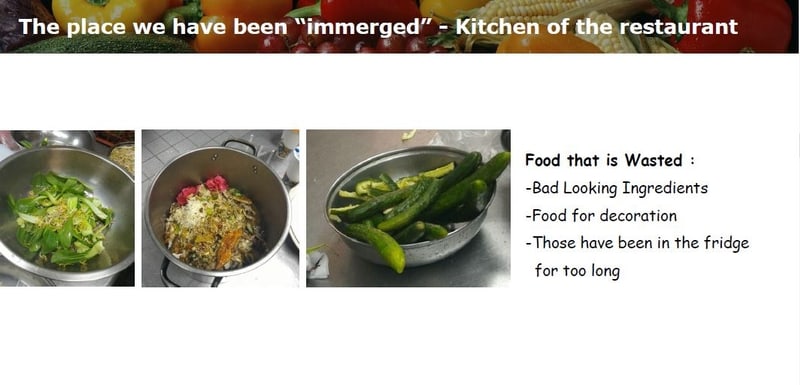
Here are some of our captures we found interesting:
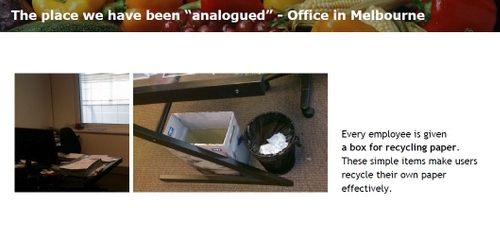
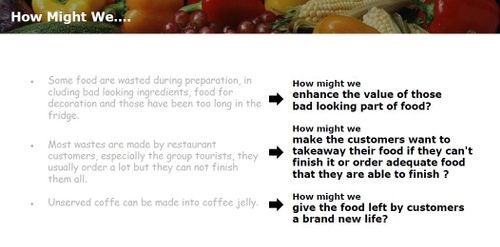
To narrow and focus our design solution, we grouped our learnings into categories and transformed them into 3 "How Might We" questions:
To turn these opportunities for design into concepts to prototype, we used Trello as our online brainstorming board and generated as many ideas as possible.
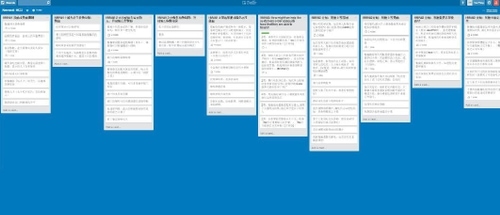
After several votes and evaluating the most promising ideas, we came up with a concept which answered "How might we make the customers order adequate food that they are able to finish ?"
Capturing the wonderful meal and posting it on social network before eating is one of the common behaviors in this smart phone generation. However, nobody took photos of the dishes that were emptied. Isn't it quite an achievement to finish your own food?
Our concept was to launch a community challenge in which people should empty all the dishes they ordered for XX days in a row. We wanted to make "No Leftover" a new fashion.
It came with an app in which people could take photos of the dishes with "before and after eating" and upload them to join the challenge. The users should also indicate the sense of satisfaction and the price of the meal while uploading to create a database where people could find the right meal in the right restaurant that suit their appetite and budget.
The system would also create your own profile of your dining preferences based on the information you had shared.
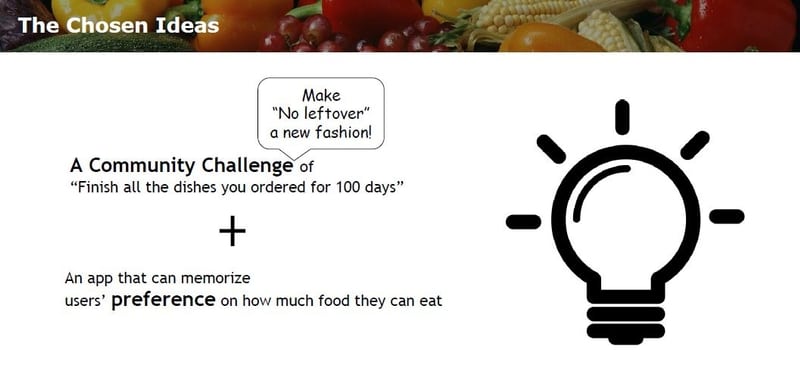
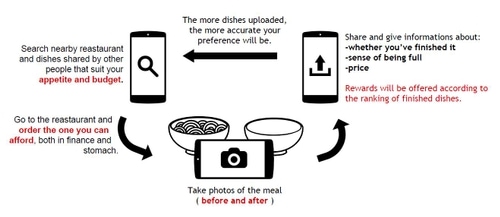
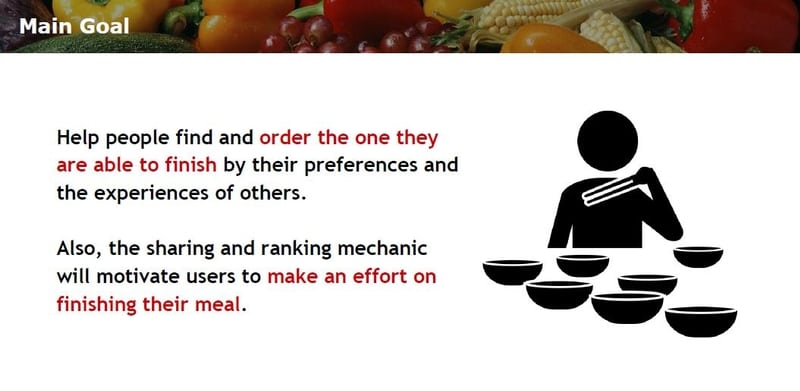
" they actually felt more motivated to empty the dishes if they expected someone will see their 'after' photos."
To test the user experience, we invited our friends to this challenge by sending us their "before and after" photos and answering a questionnaire after they ate out to simulate how the users record each meal in the app.
Most of them ( especially girls ) found the activity easy to do be carried out, while some of them would forget about it without reminding them.
It's worth noting that some said that they actually felt more motivated to empty the dishes if they expected someone will see their "after" photos. And we were happy to hear that.












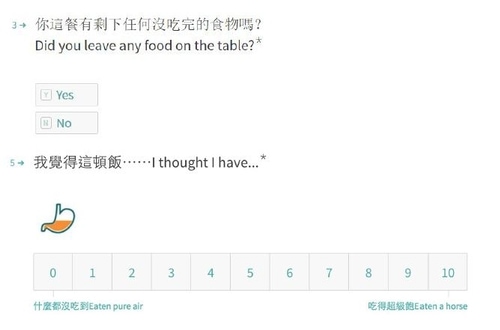
I also visualized two of the interfaces of our app:



" Since I felt homesick after living for months in Australia, I typed the keyword 'Taiwan' in search for the group to join."
Our team found each other online using the course platform.
Since I felt homesick after living for months in Australia, I typed the keyword "Taiwan" in search for the group to join. And luckily, there I found the only group with people from Taiwan!
It is always amazing for a sojourner to make contact with someone from your own country while living overseas, especially when they share the same passion with you - we all gathered in here to learn human-centered design!
In order to make a seamless group meeting experience, we used several online tools to commence our discussion like we were in the same space, including Google Hangouts, Hackpad and Trello ( it's a digital version of post-it without wasting paper).
" I learned something new every time we had meeting."
We had a senior engineer, an education entrepreneur who happens to be the facilitator of Wikimedia Taiwan, a product designer who was serving in the army ( it's mandatory for healthy young men to join military service in Taiwan for 1 year ), and me, a recent graduate in industrial design.
While everyone in the team has their own profession, social network and life pursuit, I learned something new every time we had meeting. If there was any contribution I made other than visualizing our concept, it would be my curiosity. I asked tons of questions because I was so curious about their individual stories, which I believe is crucial to the design process, and that's where inspiration comes from!




" If I had one more chance, I wished I could find a way to express my affection."
After I lost my grandpa, I realized I had never shown my love for him ever since I hit puberty. I wasn't one of those touchy-feely people who I think can easily make my grandparents feel loved. If I had one more chance, I wished I could find a way to express my affection.
I want to create something that makes the grandparents healthier and closer to their adult grandchildren.
As people grow old, they're forced to give up their health, career and their self-esteem. Hence, the love and support from the family members might become the ones they treasure the most through the rest of their lives. The following is the evidences found in the literature that indicate the significance of grandparent-grandchild (GP-GC) relationship:
" both contact frequency and GP-GC closeness declined as the grandchildren grew older."
Although scholars generally agree that the inter-generational relationship, in general, is beneficial for a grandparent’s well-being (Geurts et al., 2012). But the problem is, both contact frequency and GP-GC closeness declined as the grandchildren grew older (Hakoyama et al., 2013).

" the use of touch and physical closeness may be the most important way to communicate to persons that they are important as human beings."
There are numerous ways to improve an older adult’s health, including Therapeutic Diets, Supplements and Herbs, Yoga and Meditation (Elizabeth & Birgit, 2006). But not many methods can be both health-improving and connected to people. Massage Therapy, however, meets the need.

Massage creates connection.
Touching is an act of communication, and the use of touch and physical closeness may be the most important way to communicate to persons that they are important as human beings.
Massage makes people healthy.
Massage therapy can increase blood and lymphatic circulation, improve muscle tone, lower blood pressure, lessen pain, diminish insomnia, increase range of motion, and ameliorate agitation associated with dementia (Montague, 1986).
I refined my goal to the following:
To make adult grandchildren apply massage therapy to their grandparents.
To get an overview of different types of grandparent-grandchild relationship, I created an online survey and shared to my friends (age 23~30).
I got 40 responses and most of them are Taiwanese whose ages fall between 23 and 30.


Q: If you had a chance to give your grandparents better lives, what are the most desired values you would choose for them?



I chose one person from each categories to have deeper interview with. And defined my target users would be the grandparents and grandchildren who:

I compared three existed ways of people being massaged:


Building on the basis of the family massage, I proposed a concept that could make grandchildren apply massage therapy to their grandparents with ease and confidence.
The elements of massage therapy:






This is an ongoing project which only has the interface part so far. The designer will keep adding up some tangible components along the way in her studies.
Check the code or contribute to this project on Github.





